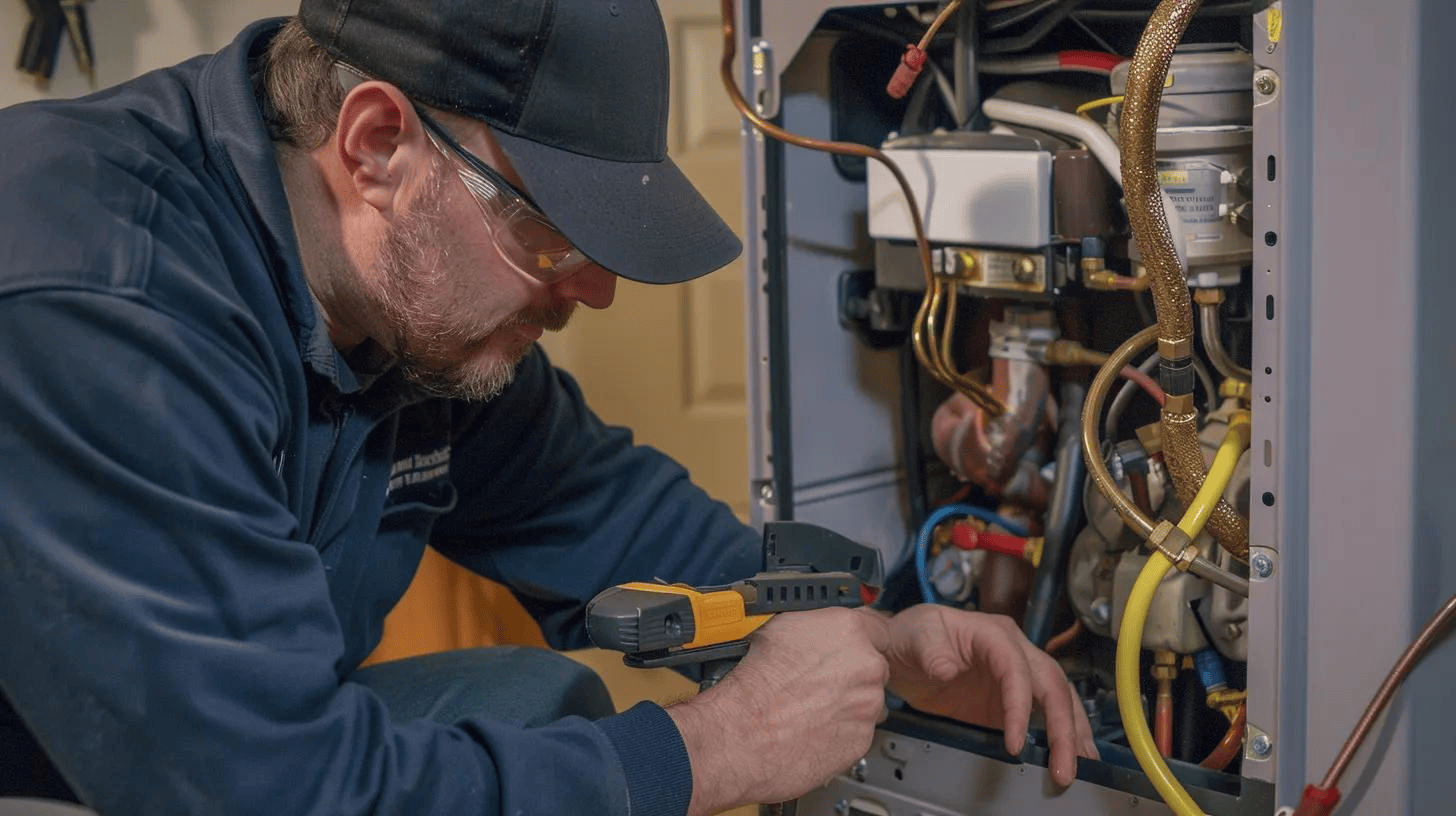

Identifying Signs Your Furnace Needs Maintenance: Key Furnace Repair and Efficiency Warning Signs
A furnace that runs efficiently keeps a home comfortable, safe, and affordable; recognizing early warning signs of furnace trouble preserves comfort and prevents costly breakdowns. This article explains what "furnace maintenance" means, why early detection matters for safety and energy efficiency, and how identifying specific symptoms can point to likely causes. You will learn the most common observable warning signs, how rising energy bills reveal efficiency issues, clear safety indicators (including carbon monoxide risks), and when to call a professional. The guide also covers preventative maintenance steps, practical DIY checks that are safe for homeowners, and how local service options can help resolve problems. Throughout, practical diagnostic checklists, EAV comparison tables, and prioritized next steps are provided so you can act confidently if your heating system shows problems.
What Are the Most Common Furnace Warning Signs to Watch For?
A furnace warning sign is any persistent change in performance, sound, smell, or cost that signals reduced safety, efficiency, or reliability. These warning signs often arise because meronyms of the furnace—like the air filter, blower motor, heat exchanger, or thermostat—are malfunctioning or obstructed, which degrades combustion or airflow. Early detection restores comfort and prevents safety risks such as carbon monoxide exposure and sudden failures during cold weather. Below are the most commonly observed signs homeowners report, each with a concise explanation to help you connect symptom to likely cause and immediate next steps. After this symptom list, you’ll find guidance on when a technician should evaluate the system.
- Strange or loud noises coming from the furnace that were not present before.
- Uneven heating with cold spots in specific rooms or floors.
- Noticeable increases in monthly heating bills without a corresponding change in use.
- Persistent short cycling where the unit turns on and off frequently.
- Burning or unusual odors when the system first starts.
- Visible soot, rust, or a yellow/flickering pilot flame instead of a steady blue flame.
These signs vary in urgency: odd noises and rapid short cycling often indicate mechanical stress that needs prompt attention, while gradually rising bills suggest efficiency loss that benefits from a tune-up. If you observe multiple signs together—especially safety-related ones—stop using the system if recommended and contact a qualified technician for diagnostic service and repair.
Which Strange Furnace Noises Indicate a Need for Repair?
Banging or booming sounds often occur when ducts or heat exchangers expand unevenly or when delayed ignition causes a small combustion "pop;" this can stress components and indicates immediate inspection is needed.
Squealing or screeching usually points to a failing blower motor bearing or a loose belt, which reduces airflow and can damage the motor over time.
Rattling and loose metallic sounds are often simple: unsecured panels, loose screws, or debris in the blower cabinet; these are usually safe to inspect visually but should be corrected soon to prevent further wear.
Grinding noises suggest deeper motor or bearing failure and require shutting down the system and calling a technician to avoid motor burnout.
Quick DIY checks—confirming the air filter is clean and panels are secured—can sometimes resolve minor rattles, but persistent or loud mechanical sounds should trigger professional service to prevent escalation.
How Do Uneven Heating and Cold Spots Signal Furnace Problems?
Uneven heating and cold spots reflect distribution or control issues that can be traced to airflow, thermostatic control, or ductwork integrity.
If one room is cold while others are warm, start with simple checks: ensure vents are open and unblocked, verify the thermostat settings and location for drafts, and inspect the air filter for heavy restriction.
If vents are warm near the furnace but cold farther away, duct leakage or insulation gaps in the attic or crawlspace are likely culprits; poor duct design or disconnected runs can also starve rooms of heated air.
System-level problems—like a failing blower motor, incorrect fan speed, or a partially obstructed heat exchanger—create broader unevenness across the home and typically demand professional diagnostic service. Tracking which rooms are affected and when the problem occurs (constant vs. intermittent) helps a technician isolate whether the issue is local (vent/room) or systemic (furnace/ductwork).
How Can Rising Energy Bills Reveal Furnace Efficiency Issues?
Rising energy bills are a measurable sign that a furnace’s efficiency has declined because the system requires more fuel or runtime to deliver the same indoor temperature. Inefficiency often results from reduced airflow (dirty filters, failing blower), poor combustion (dirty burners, improper flame color), or short cycling that increases start-up losses. Monitoring seasonal energy usage and comparing year-over-year consumption under similar weather conditions offers a practical metric for homeowners to spot efficiency drift. Below is a short diagnostic checklist and an EAV table that compares common causes, the symptom homeowners notice on utility bills, and recommended corrective actions that restore efficiency and savings.
If your bill increases notably during the heating season without greater thermostat use, use the checklist below to narrow likely causes before calling a technician.
- Check the air filter: A heavily clogged filter reduces airflow and forces longer run times.
- Watch for short cycling: Frequent on/off cycles waste energy and indicate thermostat or combustion issues.
- Inspect flame color: A healthy burner flame is blue; yellow or orange flames suggest combustion problems.
Different causes produce predictable changes in usage and should guide the next steps for repair or maintenance.
This comparison shows that many causes of higher bills are preventable through routine maintenance, filter care, and targeted repairs. Regular measurement and quick fixes often yield measurable savings and improve comfort.
What Causes High Energy Consumption in Furnaces?
High energy consumption in furnaces stems from mechanical, combustion, and distribution inefficiencies that increase cycle duration or reduce heat transfer. Key mechanical reasons include a dirty filter that constricts airflow, worn blower motors that operate inefficiently, and failing components that make the system work harder. Combustion issues—like poorly tuned burners or improper gas-air mix—reduce heat output per unit of fuel and can create safety risks. Distribution problems, such as leaky or uninsulated ductwork, force the furnace to run longer to offset heat loss. Home insulation and thermostat behavior also influence consumption: frequent setback schedules or large temperature swings can increase cycles. Few homeowner fixes are simple—filter replacement and thermostat calibration—while others require a technician’s diagnostic tools like combustion analyzers and airflow meters to quantify and remedy the root cause.
How Does Regular Maintenance Improve Furnace Efficiency?
Regular maintenance restores designed performance by optimizing each furnace meronym—cleaning burners, inspecting the heat exchanger, lubricating the blower motor, and calibrating the thermostat to ensure consistent operation.
Annual or bi-annual tune-ups typically include filter checks, blower and motor inspection, burner cleaning, and safety control tests; each task reduces wasted fuel and lowers the likelihood of emergency repairs. Evidence from industry practice indicates routine maintenance can improve efficiency noticeably, often reducing energy use by a measurable percentage and extending system lifespan by preventing premature component failure.
A simple maintenance checklist homeowners can expect during a tune-up includes filter replacement, blower inspection, thermostat calibration, flue and vent checks, and a combustion test; following these steps regularly often results in steadier indoor temperatures and lower heating costs.
What Are the Safety Warning Signs Related to Your Furnace?
Safety warning signs indicate conditions that could threaten occupant health or property and require immediate attention. These signs include a yellow or flickering pilot light, persistent gas smells, visible soot or rust on the furnace, and physical symptoms in occupants—headaches, nausea, dizziness—that might signal carbon monoxide (CO) exposure. Understanding the difference between efficiency problems and safety hazards is critical: some issues are inconvenient but not immediately dangerous, while others need emergency actions like evacuation and calling emergency services. The guidance below explains visual and health-related indicators and provides a prioritized emergency checklist to follow if you suspect a hazardous condition.
- Observe flame color and visible residue around the appliance.
- Watch for persistent or strong smells of gas or burning that do not dissipate.
- Note any unexplained symptoms among household members, such as headaches or nausea.
- Check household CO detectors’ status and alarms immediately.
If any of the above signs are present—especially gas odor or CO detector alarms—treat the situation as urgent: evacuate the home, call emergency services, and do not re-enter until the area is declared safe by professionals.
Carbon Monoxide Detectors for Faulty Furnaces
Safety Commission recommends installation of these detectors in every home where CO gas could accumulate due to faulty fossil fuel furnaces,
Carbon monoxide analysis, 2019
Why Is a Yellow or Flickering Pilot Light Dangerous?
A yellow or flickering pilot light indicates incomplete combustion, which produces soot and increases the risk of carbon monoxide formation; a proper combustion flame is steady and blue. Incomplete combustion occurs when the burner has an improper air-to-fuel ratio, burner ports are dirty, or ventilation is obstructed, and it directly undermines both efficiency and safety. Visually inspecting the flame through the furnace access panel gives an immediate signal: a persistent yellow flame warrants shutting off the gas supply to the appliance if it can be done safely, ventilating the area, and calling a qualified technician for combustion adjustments and a full safety check. Never assume a temporary color change is harmless—if the pilot light is yellow or erratic, professional inspection is the recommended next step to verify safe combustion.
What Are the Signs of a Carbon Monoxide Leak from a Furnace?
Carbon monoxide leaks present as non-specific human symptoms and specific appliance indicators that together should prompt emergency action. Occupant symptoms include headache, dizziness, nausea, confusion, and flu-like feelings that improve when away from the home—these patterns suggest possible CO exposure. Appliance and environmental signs include soot accumulation near the furnace, a yellow or lazy flame, excessive rust or corrosion on venting, and staining on surrounding walls or ceilings. If a CO alarm sounds or occupants experience symptoms, evacuate immediately, call emergency services, and seek medical evaluation for anyone affected; afterward, a certified technician should perform a combustion and ventilation inspection before the furnace is used again. Install and maintain CO detectors and ensure annual inspections include heat exchanger and flue assessments to reduce CO risk.
When Should You Call a Professional for Furnace Maintenance or Repair?
Deciding when to call a professional depends on symptom severity, safety risk, and DIY scope; red-flag signs and safety issues require immediate professional attention. Homeowners can handle routine tasks—filter changes, thermostat checks, and ensuring vents are clear—but should call a technician for persistent strange noises, visible soot, yellow flames, short cycling, loss of heat, or electrical smells. A prioritized list below helps homeowners triage problems and choose appropriate next steps. After the list, practical guidance on repair-versus-replace decisions and local emergency service expectations is provided.
- Call immediately for gas smells, CO alarm activation, heavy soot, or occupants feeling unwell.
- Schedule ASAP for loud mechanical noises, recurrent short cycling, or loss of heat.
- Book routine service for gradual efficiency loss, rising bills, or annual tune-ups.
When evaluating repair versus replacement, consider system age, efficiency loss, and the cost of the recommended repair relative to replacement. Common guidance is that if a repair approaches half the cost of a new system and the furnace is older with repeated problems, replacement is often the more cost-effective route. In Central Texas, emergency scenarios like total no-heat during a cold snap or CO concerns typically require rapid response; reputable providers offer 24/7 emergency service to restore safety and comfort.
How to Distinguish Between Furnace Repair and Replacement Needs?
Assess repair vs. replacement using clear criteria: furnace age, frequency of repairs, current efficiency compared to modern units, and the estimated repair cost relative to replacement price. If a furnace is nearing the end of its expected lifespan, has required multiple repairs in a short period, or if a single repair exceeds roughly 50% of replacement cost, replacement becomes more attractive. Safety issues—like a cracked heat exchanger or repeated combustion problems—also push toward replacement to avoid ongoing risk. Always obtain a professional diagnostic estimate to compare repair costs and projected efficiency gains from replacement, and factor in any available financing or reimbursement programs that may alter the financial calculus.
What Emergency Furnace Repair Services Are Available in Central Texas?
Emergency furnace repair services typically include immediate safety assessments, on-site diagnostics, temporary repairs to restore heat or safe operation, and full-service follow-up for permanent fixes. In Central Texas, homeowners should expect providers that offer 24/7 emergency response for scenarios such as loss of heat in extreme temperature conditions, gas leaks, or suspected carbon monoxide events.
During an emergency call, technicians prioritize occupant safety: they perform combustion and CO checks, isolate fuel supply if required, and advise on evacuation steps when necessary. Expect a rapid triage that separates immediate hazards from non-urgent repairs and a clear explanation of next steps, estimated timelines, and any temporary measures to keep the home safe until a full repair or replacement can be completed.
Conclusion
Recognizing the signs that your furnace needs maintenance is crucial for ensuring safety, efficiency, and comfort in your home. By addressing issues like strange noises, rising energy bills, and safety warnings promptly, you can prevent costly repairs and enhance your furnace's performance. Don't wait for a breakdown; take proactive steps to maintain your heating system and ensure a warm, safe environment. Explore our expert maintenance services today to keep your furnace running smoothly.
Recent Posts
Customer Testimonials




